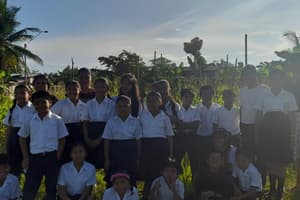Podcast
Questions and Answers
Which subgroup within Hymenoptera is considered to have the largest superfamilies?
Which subgroup within Hymenoptera is considered to have the largest superfamilies?
- Chalcidoidea (correct)
- Ichneumonoidae (correct)
- Proctotrupoidea
- Vespoidea
What is one of the significant problems associated with the over-reliance on pesticides?
What is one of the significant problems associated with the over-reliance on pesticides?
- Increase in beneficial insects
- Improved pest resistance
- Emergence of secondary pests (correct)
- Higher crop yields
Why is biological control considered environmentally safe?
Why is biological control considered environmentally safe?
- It is ineffective against pests
- It uses synthetic chemicals
- It creates secondary pest problems
- It reduces pesticide resistance (correct)
Which order includes the family Tachnidae?
Which order includes the family Tachnidae?
What is one characteristic of the suborder Parasitica within Hymenoptera?
What is one characteristic of the suborder Parasitica within Hymenoptera?
What characteristic is commonly associated with adult lady beetles?
What characteristic is commonly associated with adult lady beetles?
What is a common trait of mantids as predators?
What is a common trait of mantids as predators?
Which statement accurately describes predatory mites?
Which statement accurately describes predatory mites?
Which of these predators is noted for being polyphagous?
Which of these predators is noted for being polyphagous?
What is the main factor affecting prey selection by predators?
What is the main factor affecting prey selection by predators?
What type of organisms do baculoviruses primarily affect?
What type of organisms do baculoviruses primarily affect?
Which group does Bacillus thuringiensis belong to?
Which group does Bacillus thuringiensis belong to?
What is a distinguishing feature of baculoviruses?
What is a distinguishing feature of baculoviruses?
What condition is primarily caused by Bacillus popilliae?
What condition is primarily caused by Bacillus popilliae?
Which of the following describes the reproductive method of bacteria?
Which of the following describes the reproductive method of bacteria?
What is a common characteristic of nuclear polyhedrosis viruses (NPVs)?
What is a common characteristic of nuclear polyhedrosis viruses (NPVs)?
What is the primary symptom associated with ascoviruses in larvae?
What is the primary symptom associated with ascoviruses in larvae?
What feature distinguishes spore-forming bacilli like Bacillus thuringiensis?
What feature distinguishes spore-forming bacilli like Bacillus thuringiensis?
What is the main method of reproduction for protozoa?
What is the main method of reproduction for protozoa?
Which characteristic is NOT associated with competitive saprophytic ability?
Which characteristic is NOT associated with competitive saprophytic ability?
What are protozoa primarily categorized by?
What are protozoa primarily categorized by?
What is mycophagy?
What is mycophagy?
Which of the following is a soil pathogen?
Which of the following is a soil pathogen?
Which of these statements best describes competition?
Which of these statements best describes competition?
Which of the following characteristic does NOT enhance competitive saprophytic ability?
Which of the following characteristic does NOT enhance competitive saprophytic ability?
Which of these organisms is included in the group of antagonistic soil amoebae?
Which of these organisms is included in the group of antagonistic soil amoebae?
What is the botanical name for blue weed?
What is the botanical name for blue weed?
Which type of weeds are generally not suitable for the method discussed?
Which type of weeds are generally not suitable for the method discussed?
What is a common issue associated with poisonous weeds regarding the method of control discussed?
What is a common issue associated with poisonous weeds regarding the method of control discussed?
Preliminary surveys for biocontrol could determine what aspect regarding potential parasites?
Preliminary surveys for biocontrol could determine what aspect regarding potential parasites?
Which of the following weeds was targeted using a conventional approach for control?
Which of the following weeds was targeted using a conventional approach for control?
What does the complexity of parasitoid nutrition influence according to Salt's studies?
What does the complexity of parasitoid nutrition influence according to Salt's studies?
Which factor is not mentioned as influencing parasite growth and survival?
Which factor is not mentioned as influencing parasite growth and survival?
What type of weeds are usually not suited for handling minor weed problems?
What type of weeds are usually not suited for handling minor weed problems?
What is the 'Rule of Sameness' in relation to nutritional requirements?
What is the 'Rule of Sameness' in relation to nutritional requirements?
Which of the following is an example of direct defense in plants against herbivores?
Which of the following is an example of direct defense in plants against herbivores?
Which of the following dietary components was used to support the larval development of Coleomegilla maculata?
Which of the following dietary components was used to support the larval development of Coleomegilla maculata?
Which substances are considered indirect defenses in plants?
Which substances are considered indirect defenses in plants?
What type of insects are nutritional requirements similar to those of entomophagous species?
What type of insects are nutritional requirements similar to those of entomophagous species?
What is a primary benefit of using in vitro culture for parasitoids?
What is a primary benefit of using in vitro culture for parasitoids?
Which of the following diets was utilized historically for rearing certain insect species?
Which of the following diets was utilized historically for rearing certain insect species?
What did the Philippines implement in 2010 regarding pest management?
What did the Philippines implement in 2010 regarding pest management?
Flashcards
Biological Control
Biological Control
Using natural enemies (like insects) to control pests. It's like hiring a team of tiny superheroes to protect your crops!
Parasitica
Parasitica
These wasps are the main players in biological control because they parasitize other insects by laying eggs in them.
Chalcidoidea
Chalcidoidea
These wasps belong to a superfamily known for parasitizing pests and providing excellent biological control.
Problems with Pesticide Reliance
Problems with Pesticide Reliance
Signup and view all the flashcards
Benefits of Biological Control
Benefits of Biological Control
Signup and view all the flashcards
Polyphagous Predators
Polyphagous Predators
Signup and view all the flashcards
Mantids
Mantids
Signup and view all the flashcards
Predatory Mites
Predatory Mites
Signup and view all the flashcards
Ladybird Beetle
Ladybird Beetle
Signup and view all the flashcards
Ground Beetles
Ground Beetles
Signup and view all the flashcards
Bacteria
Bacteria
Signup and view all the flashcards
Ascoviruses
Ascoviruses
Signup and view all the flashcards
Baculoviruses
Baculoviruses
Signup and view all the flashcards
Nuclear Polyhedrosis Virus (NPV)
Nuclear Polyhedrosis Virus (NPV)
Signup and view all the flashcards
Bacillus thuringiensis
Bacillus thuringiensis
Signup and view all the flashcards
Paenibacillus popilliae
Paenibacillus popilliae
Signup and view all the flashcards
Spore-forming bacilli
Spore-forming bacilli
Signup and view all the flashcards
Bacillaceae
Bacillaceae
Signup and view all the flashcards
Protozoa
Protozoa
Signup and view all the flashcards
Competition
Competition
Signup and view all the flashcards
Microbial Iron Chelation
Microbial Iron Chelation
Signup and view all the flashcards
Competitive Saprophytic Ability
Competitive Saprophytic Ability
Signup and view all the flashcards
Mycophagy
Mycophagy
Signup and view all the flashcards
Saprophytic Protozoa
Saprophytic Protozoa
Signup and view all the flashcards
Symbiosis
Symbiosis
Signup and view all the flashcards
The Rule of Sameness
The Rule of Sameness
Signup and view all the flashcards
Direct Plant Defense
Direct Plant Defense
Signup and view all the flashcards
Indirect Plant Defense
Indirect Plant Defense
Signup and view all the flashcards
Quantitative Nutrient Balance
Quantitative Nutrient Balance
Signup and view all the flashcards
Predator Culture In Vitro
Predator Culture In Vitro
Signup and view all the flashcards
Parasitoids Culture In Vitro
Parasitoids Culture In Vitro
Signup and view all the flashcards
e-PHYTOSANITARY Certification System
e-PHYTOSANITARY Certification System
Signup and view all the flashcards
Digestibility Reducers
Digestibility Reducers
Signup and view all the flashcards
Biological Control of Weeds
Biological Control of Weeds
Signup and view all the flashcards
Parasitoid Control
Parasitoid Control
Signup and view all the flashcards
Plant Pathogens as Biocontrol
Plant Pathogens as Biocontrol
Signup and view all the flashcards
Why Biological Control Is Not Appropriate for Related Weeds
Why Biological Control Is Not Appropriate for Related Weeds
Signup and view all the flashcards
Surveys for Parasites
Surveys for Parasites
Signup and view all the flashcards
Effectiveness of a Parasite
Effectiveness of a Parasite
Signup and view all the flashcards
Study Notes
Biological Control Agents
- Biological control involves using natural enemies to control pests
- Over-reliance on pesticides creates problems like environmental hazards, occupational hazards, emergence of secondary pests, and pesticide resistance
- Biological control is environmentally safe and cost-effective
- Invasive species, pesticide resistance, limited pesticide development, and chemical pesticide ineffectiveness are reasons to use biological control
Parasites/Parasitoids
- Parasitoids are a type of biological agent
- Parasitoids kill their host
- They attack specific life stages of the host
- They attack fewer species of hosts than predators
- Most parasitoids are Hymenopterans (largest order)
- Other orders include Diptera (flies), Strepsiptera (twisted-wing parasites), and Coleoptera (beetles)
Predators
- Predators kill multiple prey
- They often target both adults and immature populations
- Many predators are polyphagous (attack many species)
- Predators are present in all habitats, are often mobile, and prey selection is often size-dependent
- Examples include true bugs, lacewings, ground beetles, ladybird beetles, syrphid flies, and fire ants.
Pathogens of Insects
- Pathogens (viruses, bacteria, fungi, or protozoa) cause diseases in insects
- Different groups cause different diseases and have various characteristics
- Viruses: obligate intracellular parasites, some create occlusion bodies (NPVs, GVs)
- Bacteria: simple unicellular organisms, reproduce by binary fission. E.g., Bacillus thuringiensis, Serratia entomophila, Bacillus sphaericus, and Paenibacillus popilliae.
- Fungi: eukaryotic organisms lacking chloroplasts, live in various environments, exist as a vegetative phase. E.g. those in Coelomyces and Lagenidium (aquatic), Metarhizium and Beauveria (terrestrial)
- Protozoa: diverse group, can be free-living or parasitic
Plant Pathogens as Biocontrol
- Conventional approach involves introduction of host-specific rusts (e.g., Puccinia chondrillina, which was introduced to control skeleton weed in Australia)
- Biological herbicides involve use of fungal spores to control weeds
Competitive Saprophytic Ability
- The ability of an organism to successfully compete for resources
- Four key characteristics are important: (i) rapid germination; (ii) appropriate enzyme equipment; (iii) excretion of fungistatic and bacteriostatic growth products; (iv) tolerance of fungistatic substances.
Inoculum Potential
- The potential for an organism to establish a population in a new area
- Measures of success depend on factors like the species, the target of the biological control, and the potential for the biological control agent to achieve its objectives
Native Weed Species
- Native species may not be suitable for biological control due to factors like resistance to the control agents, or they might pose threats or disrupt native ecosystems.
Quarantine and Exclusion
- Quarantine facilities are used to prevent introductions of organisms that could disrupt other environments
Studying That Suits You
Use AI to generate personalized quizzes and flashcards to suit your learning preferences.





